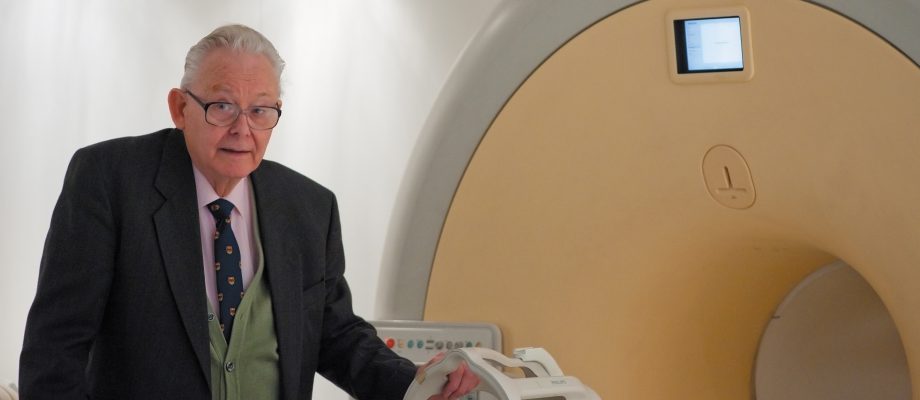
Professor Sir Peter Mansfield FRS, 1933-2017
February 9th, 2017
Tributes have been paid to Nobel laureate Professor Sir Peter Mansfield, who has died at the age of 83.
Sir Peter pioneered the creation of Magnetic Resonance Imaging (MRI), one of the most important and revolutionary breakthroughs in modern medical science.
He was awarded the Nobel Prize for Physiology or Medicine in 2003 for his role in the development of MRI, which is used today in research, diagnosis and the treatment of millions of patients around the world.
The Sir Peter Mansfield Imaging Centre at The University of Nottingham was named in honour of his pioneering work to change the face of modern medical science.
Sir Peter’s family said today:
“It is with great sadness that Lady Mansfield and family would like to announce the passing away of Sir Peter, on Wednesday evening, 8th February.
“As well as being an eminent scientist and pioneer in his field, he was also a loving and devoted husband, father and grandfather who will be hugely missed by all the family.”
Sir Peter was born in London in 1933, joining the University of Nottingham as a physics lecturer in 1964.
Together with the late Paul Lauterbur, Sir Peter harnessed nuclear magnetic resonance (NMR) to visualise the internal structure of complex objects. In 1976 they produced the first human NMR image, a finger complete with bone, bone-marrow, nerves and arteries. Two years later, Sir Peter became the first person to step inside the very first whole-body scanner, so that it could be tested on a human subject — despite warnings that it could be potentially dangerous.
Their research revolutionised the world of diagnostic medicine and in 2003 received world acclaim when they shared the Nobel Prize for Physiology or Medicine. His long career also included many other distinguished awards including a knighthood, an MRC Millennium Medal, Fellowship of the Royal Society and a number of honorary degrees.
Sir Peter stayed at The University of Nottingham for his entire career, retiring in 1994. He was made Emeritus Professor and continued to collaborate with colleagues at the Sir Peter Mansfield Imaging Centre at The University of Nottingham, remaining passionate about his work.
Only last month, he joined with colleagues on University Park to celebrate the 25th anniversary of the opening of the Centre on campus.
Professor Sir David Greenaway, Vice-Chancellor of the University, paid tribute to the pioneer of MRI.
Sir David said: “Few people can look back on a career and conclude that they have changed the world. In pioneering MRI, that is exactly what Sir Peter Mansfield has done, he has changed our world for the better. As a scientific leader and a highly prized colleague, he will be greatly missed in our University. But he has left an extraordinary legacy which will continue to inspire others to change the world.”
Professor Peter Morris CBE was a young PhD student when he first worked with Sir Peter, and knew him for more than 40 years.
Professor Morris, who still works at the School of Physics and Astronomy, said: “Today, MRI has lost the rock on which it was founded. Sir Peter’s pioneering research has revolutionized diagnostic medicine and all of us have felt its benefits.
“He has been the defining influence on my life as supervisor, colleague and friend. We will not see his like again.”
Sir Peter’s invention of an extremely fast scanning MRI technique, known as echo-planar imaging (EPI), underpins the most sophisticated MRI applications in clinical use today. EPI is the key to functional MRI (fMRI), which is used to study dynamic processes in living organisms. Before EPI, fMRI was slow and hard to use clinically. EPI speeded up image acquisition and therefore underpins all modern fMRI applications.
MRI and fMRI have transformed neuroscience and physiology research by opening windows on the working brain and body. MRI provides detailed images of anatomical structure and can detect cancer and signs of damage in the body’s bones, tissues and organs. fMRI allows doctors to study brain activity during development, following injury and in brain disorders. It has also been used to investigate how the brain’s neural networks develop during infancy, and to look for subtle abnormalities in brain activity in patients with disorders including attention deficit hyperactivity disorder, schizophrenia and Alzheimer’s disease.
Sir Peter is survived by his wife, Lady Mansfield, his two daughters and four grandchildren.
The University has set up an online book of condolence in tribute to Sir Peter.
If you wish to make a donation, this can be done online, or if you prefer, you can bring a donation on the day as there will be a donations box in church. All donations will go to the Nottingham City Hospital Stroke Unit.
View a photo gallery of Sir Peter on our blog.
Read a blog post from Professor Sir David Greenaway, Vice-Chancellor, paying tribute to Sir Peter.
Tags: magnetic resonance imaging, medicine, MRI, Nobel Prize, obituary, Peter Mansfield, Peter Morris, science, Sir Peter Mansfield Magnetic Resonance Imaging
Comments are closed.
Other

Need news? See you on SharePoint
After 14 years of service, Campus News is being retired as the university’s staff news platform. […]

Roads and car parks closed for refurbishing work
As part of ongoing road improvements at the university, works will be taking place to resurface […]

